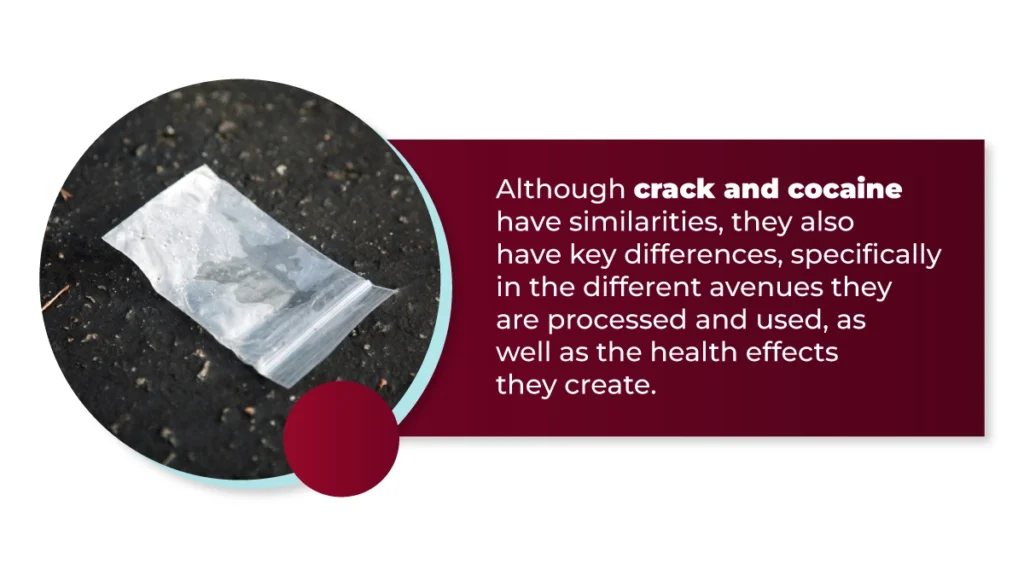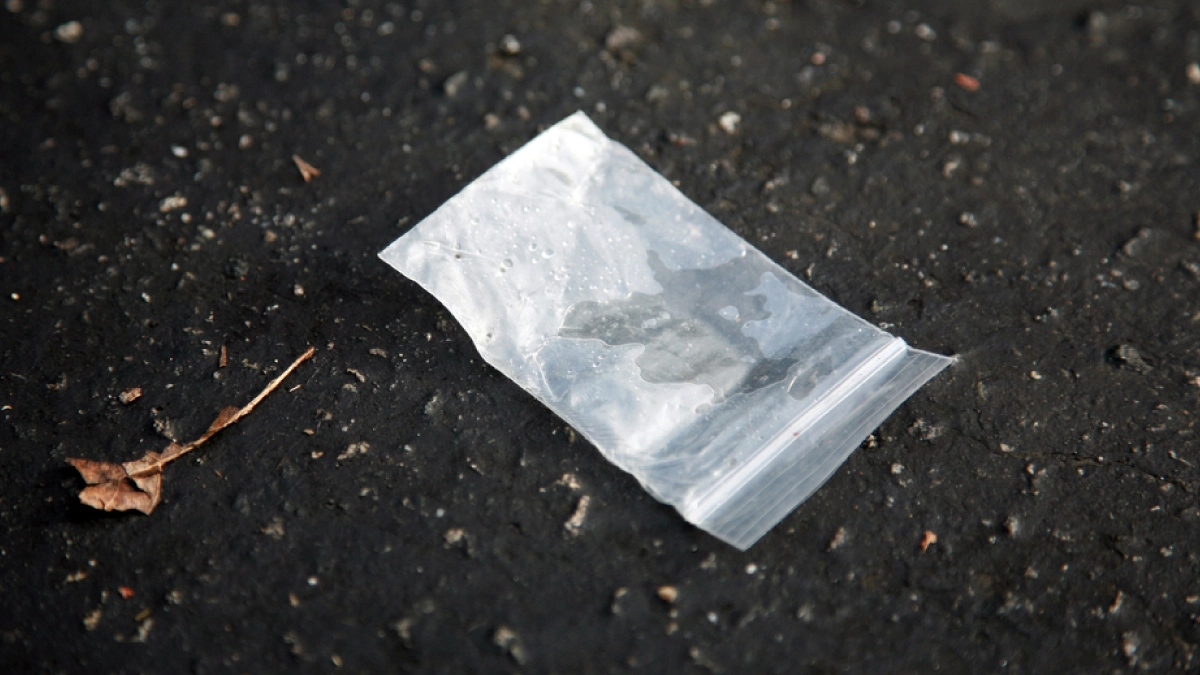Crack and cocaine are both powerfully addictive drugs. Each substance is derived from the coca plant, which is indigenous to South America. The chemical in the plant leaves has a strong stimulant effect on the central nervous system, which has the potential for an individual to become addicted. Although crack and cocaine are similar, both substances have significant differences.
Key Takeaways
Crack and cocaine both have different origins, forms, short-and long-term effects, and other concerning factors.
- Crack and cocaine each pose risks of addiction, overdose, and death.
- Cocaine is a white powder processed from its natural form of hydrochloride salt that is snorted or injected into veins.
- Crack is the free base processed from cocaine that is formed into an off-white crystalized rock that is mainly smoked.
- Crack and cocaine use can develop into addiction from a single use because of the high it produces
Although crack and cocaine are similar yet different, they are both highly addictive and extremely dangerous to use. Reach out to Indiana Center for Recovery to learn more about crack and cocaine addiction recovery.
What is Cocaine?
Cocaine, frequently referred to as coke, snow, or blow, is a highly addictive stimulant extracted from the coca leaves. Hydrochloride salt is the natural form of cocaine. People refine the salt into a paste, which is then finely processed into a white crystalline powder. People inhale the powder through their noses, rub it on their gums, or dissolve the powder in water to inject it into veins.
Depending on how people ingest the powder, the effects of cocaine can occur immediately or within a short time after use. When the drug is snorted, the effects typically take between three to five minutes to kick in, and the high can last from 15 to 30 minutes. When people inject the substance into their veins, the high occurs quickly, within as little as 15 to 30 seconds.
Even though cocaine use is short-lived, it produces an intense feeling of confidence and energy. The white powder causes a rush of dopamine into the brain, causing a feeling of euphoria. The brain is overwhelmed by the effects of stimulation, causing the brain’s neurotransmitter to produce feel-good chemicals.
The chemicals deteriorate quickly, causing people to experience a drastic drop where they feel a large wave of sadness or even depression. The cravings and emotions during a comedown are what typically cause people to use cocaine again to avoid or stop feeling the negative effects.
What is Crack?
Crack, also known as crack cocaine, consists of the same chemical makeup as cocaine but is made into a different form. The hydrochloride salt, a non-psychoactive substance, is removed during the transformation process.
When the process is finished, the crack is then composed of an off-white crystalized rock form. These rocks are a highly concentrated form of cocaine that is smoked by users.
When crack is smoked, it hits the bloodstream quicker than when people inject cocaine and lasts between five to 10 minutes. The smoke causes problems and damage to the lungs, unlike cocaine use.
Crack affects the brain the same way as cocaine does. Similarly to cocaine, the high is also short-lived with an intense comedown, causing people to keep using the drug to avoid the crash and depression that follows.
How Crack and Cocaine Differ

Although crack and cocaine have similarities, they also have key differences, specifically in the different avenues they are processed and used, as well as the health effects they create.
Below are some detailed differences between the two drugs.
Chemical Makeup
Cocaine and crack are two substances that are made into two different forms. Cocaine’s natural element is hydrochloride salt, which, when processed, is made into a white powder. Crack is made out of cocaine by adding ammonia or baking soda, which is then heated to remove the hydrochloride salt. This process is known as free-basing, which results in a solid, rock-like substance.
Methods of Use
Cocaine powder is normally snorted through the nose and rubbed on the gums. Some people inject the drug directly into their bloodstream through their veins. When cocaine is snorted, it enters the bloodstream through the inner nasal linings, taking a couple of minutes for the effect to kick in.
When cocaine is injected, people feel an intense, immediate euphoric rush. People may also mix cocaine with opioids such as heroin, fentanyl, or even meth. When these drugs are mixed, known as a speedball, the chances of overdose increase. When injected, the euphoric rush lasts shorter than when snorted.
Unlike cocaine, crack is typically smoked, producing a quicker effect of an intense euphoric rush within seconds, and is shorter-lived than when snorting cocaine.
Because both drugs only last between five-20 minutes, depending on how the substance is administered, individuals may repeat use and increase the dosage amount. In doing so, people are at risk of developing health complications.
Side Effects of Crack and Cocaine Use
Both cocaine and crack have many effects and can even be life-threatening. Here are some examples of the similar effects associated with crack and cocaine use.
- Increased heart rate
- Increased blood pressure
- Dilated pupils
- Cardiac arrest
- Seizures
- Stroke
- Heart attack
- Constricted blood vessels
- Elevated body temperature
- Tremors or muscle twitches
- Violent behaviors
- Abnormal behavior
- Paranoia
- Restlessness
- Nausea
Using cocaine regularly may result in an individual’s developing a tolerance. When tolerance is developed, people will require frequent and higher doses to feel the euphoric effect desired. Individuals may binge the drug, which can cause psychological and physiological effects that can lead to overdose.
Long-term cocaine use in all forms of administration can affect the neurological and cardiovascular systems as well as damage the liver and kidneys and may lead to death. When people snort cocaine for a long period, they can damage the nasal cavity, causing nosebleeds, chronic runny nose, and loss of sense of smell. When injecting cocaine, individuals are at risk for contracting infectious diseases like HIV and hepatitis C.
When people smoke crack, the use can affect the respiratory system, such as lung damage, coughing, asthma, respiratory distress, and increased risk of respiratory infections. Similar to cocaine, long-term crack use can also cause psychological and physiological health risks that can also result in overdose.
Risk of Overdose
Cocaine and crack can both result in overdose whether people are long-term users or experimenting for the first time. When users combine these drugs with alcohol or heroin, it can significantly increase overdose chances.
Both crack and cocaine are deadly and have caused over 15,000 overdose deaths over the last couple of years. However, crack is more likely to cause overdose because of the larger dosages consumed when smoking. Symptoms of overdose include:
- Difficulty breathing or shortness of breath
- High blood pressure
- Increased body temperature
- Hallucinations
- Extreme agitation
- Abnormal heartbeat
- Heart attack
- Seizure
- Stroke
If you or someone is experiencing these symptoms, call 911 right away. There are no reversible at-home solutions for a crack or cocaine overdose, which is why emergency medical care is required to prevent death. Medical professionals reestablish blood flow to the heart, allowing oxygen to the brain. If a person is having a seizure, medical professionals can administer medication to control or stop the seizure.
Drug Impurities
To increase drug profits, dealers frequently mix or “cut” cocaine and crack with other substances or chemicals. Some additives can be harmless, such as cornstarch and flour. However, other substances can be harmful and dangerous, such as amphetamines and fentanyl.
Fentanyl, an opioid, is a deadly drug that only requires small amounts to be lethal. Amphetamines, which are stimulants, enhance the stimulant effect of crack and cocaine. When either substance is added to crack and cocaine, it can increase the risks of heart attack, stroke, and cardiac arrest. Sometimes ephedrine and caffeine, also stimulants, can be added to crack and cocaine and can also result in life-threatening risks that were mentioned previously.
Crack and Cocaine Addiction
People can become addicted to crack and cocaine from the first use because of the dopamine rush. As more dopamine is released, causing a euphoric feeling, individuals’ sensitivity decreases to normal dopamine levels.
People chase the high that they experienced from their first use, but it becomes difficult to achieve because tolerance builds. When tolerance is built, people increase usage and dosage amounts and are at risk of overdose. However, people who become dependent on crack and cocaine can experience withdrawal symptoms when they stop using.
Here are examples of some signs and symptoms of crack and cocaine addiction:
- Abnormal mood swings
- Extreme anger
- Isolation from family and friends
- Stealing
- Lying about drug use
- Decrease in personal hygiene and appearance
- Absence from work or school
- Neglecting daily responsibilities
If you notice signs of an addiction in yourself or a loved one, don’t be afraid to reach out for professional help.
Frequently Asked Questions (FAQ)
What is the difference between crack and cocaine?
The fundamental difference between crack and cocaine is their purity, form, and the way it is administered. Cocaine is a powder substance that is typically inhaled through the nose. Crack is processed from cocaine and formed into a crystalized rock and smoked. Crack produces a more intense and immediate rush but lasts shorter than cocaine.
How does cocaine and crack differ in terms of their use and effects on the body and mind?
Cocaine is normally snorted and absorbed into the bloodstream, causing a short rush. It can also be injected into the bloodstream and produces a more immediate, intense, euphoric feeling. Crack is smoked and absorbed into the bloodstream quicker than when snorting cocaine and produces a similar effect when cocaine is injected.
Both crack and cocaine highs are short-lived. Because both substances are highly addictive, people can develop severe mental and physical side effects. Crack tends to cause more intense cravings and withdrawal symptoms than cocaine.
How does the severity of addiction vary between crack and cocaine usage?
The severity of addiction can be more pronounced with crack than cocaine. This is due to the intense, immediate high from crack, which can create a strong addiction. Cocaine has a less immediate and more sustained high when snorted. However, if used by injecting, then it can be equally addictive as it produces the same rush.
Get Help Today
Cocaine and crack addiction is dangerous and harmful. If you or a loved one is struggling with addiction to crack or cocaine, Indiana Center for Recovery is here to provide you with proper treatment. Don’t wait to seek help. Contact us today to speak with one of our team members. They can help answer your questions and find you the best course of treatment. Take the first step now and get the help you need for a brighter future.
Verify Insurance
Let’s get you or a loved one help with a few simple steps.

